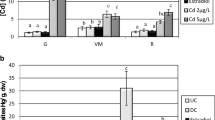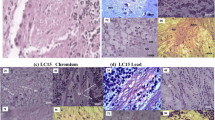Abstract
Individuals of the crayfish Procambarus clarkii (males and females) were exposed simultaneously to cadmium and zinc during 21 days. Exposure concentrations were those determined at the Guadiamar river after the Aznalcóllar mining spill (SW, Spain): 10 and 30 μg L−1 of cadmium and 1000 and 3000 μg L−1 of zinc. Three biomarkers (MT: metallothioneins like proteins, VTG: vitellogenin/vitellin like proteins and histopathology) together with heavy metal bioaccumulation were determined in soft tissues of male and female P. clarkii. At the concentrations tested, increasing cadmium exposure resulted in increasing cadmium bioaccumulation and increasing subletal effects (induction of MT, VTG and histopathological damage in tissues). Nevertheless, although increasing zinc exposure showed increasing VTG induction and histopathological damages, not a positive relationship was determined with MT induction. Concerning to responses determined in male and female crayfishes only differences were found between sexes at the highest cadmium exposure concentration related to bioaccumulation in hepatopancreas tissues. Biomarkers responses to heavy metal contamination in this crayfish, even VTG induction not before tested in heavy metal contamination assessment in crustaceans resulted potential tools for the monitoring of heavy metal environmental contamination.
Similar content being viewed by others
References
Amiard, J. C., Amiard-Triquet, C. and Métayer, C.: 1985, “Experimental study of bioaccumulation, toxicity and regulation of some trace metals in various estuarine and coastal organisms”, Symp. Biol. Hung. 29, 313–323.
Amiard, J. C., Pineau, A., Boiteau, H. L., Metayer, C. and Amiard-Triquet, C.: 1987, “Application of atomic absorption spectrophotometry using Zeeman effect, to the determination of eight elements (Ag, Cd, Cr, Cu, Mn, Ni, Pb and Se) in biological materials”, Water Res. 21, 663–697.
Barka, S., Pavillon, J. F. and Amiard, J. C.: 2001, “Influence of different essential and non-essential metals on MTLP levels in the Copepod Tigriopus brevicornis”, Comp. Biochem. Physiol. 128 C, 479–493.
Bondgaard, M., Nøum, U. and Bjerregaard, P.: 2000, “Cadmium accumulation in the female shore crab Carcinus maenas during the moult cycle and ovarian maturation”, Mar. Biol. 137, 995–1004.
Bradford, M. B.: 1976, “A rapid and sensitive method for the quantification of microgram quantities of protein utilizing the principle of protein-dye binding”, Anal. Biochem. 72, 248–254.
Couillard, Y., Campbell, P. G. C., Tessier, A., Pellerin-Massicotte, J. and Auclair, J. C.: 1995, “Field transplantation of a freshwater bivalve, Pyganodon grandis, across a metal contamination gradient. I. Temporal changes in metallothionein and metal (Cd, Cu, and Zn) concentrations in soft tissues”, Can. J. Fish Aquat. Sci. 52, 690–702.
Fingerman, M., Jackson, N. C. and Nagabhushanam, R.: 1998, “Hormonally-regulated functions in crustaceans as biomarkers of environmental pollution”, Comp. Biochem. Physiol. 120, 343–350.
Flammarion, P.: 2000, “Mesure d”un biomarqueur de pollution chez des poisons d'eau douce, validation et optimisation. Gestion des milieux aquatiques', 15, CEMAGREF, ed., Lyon, France, p. 126.
George, S. G., Burgess, D., Leaver, M. and Frerichs, N.: 1992, “Metallothionein induction in cultured fibroblast and liver of a marine flatfish, the turbot Scopthalmus maximus”, Fish Physiol. Biochem. 10, 43–54.
Gómez-Parra, A., Forja, J. M., Del Valls, T. A., Sàenz, I. and Riba, I.: 2000, “Early contamination by heavy metals of the Guadalquivir Estuary after the Aznalcóllar mining spill (SW Spain)”, Mar. Poll. Bull. 40, 1115–1123.
Gutiérrez-Yurrita, P. J. and Montes, C.: 1998, “Environmental factors controlling crayfish Procambarus clarkii activity in the Doñana National Park freshwater marsh (SW-Spain)”, Comp. Biochem. Physiol. 120 A, 713–721.
Habsburgo-Lorena, A. S.: 1979, “Present situation of exotic species of crayfish introduced into Spanish continental waters”, Freshwater Crayfish 4, 175–184.
Kime, D. E., Nash, J. P. and Scott, A. P.: 1999, “Vitellogenesis as a biomarker of reproductive disruption by xenobiotics”, Aquaculture 177, 345–352.
Martýnez, M., Torreblanca, A., Del Ramo, J., Pastor, A. and Dýaz Mayans, J.: 1993, “Cadmium induced metallotionein in hepatopancreas of Procambarus clarkii: Quantification by a silver-saturation method”, Comp. Biochem. Physiol. 105 C, 263–267.
Lee, R. F.: 1993, “Passage of xenobiotics and their metabolites from hepatopancreas into ovary and oocytes of blue crabs, Callinectes sapidus: Possible implications for vitellogenesis”, Mar. Environ. Res. 35, 181–187.
Lee, R. F. andWalker, A.: 1995, “Lipovitellin and lipid droplet accumulation in oocytes during ovarian maturation in the blue crab Callinectes sapidus”, J. Exp. Zool. 271, 401–412.
López-Barea, J. and Pueyo, C.: 1997, “Mutagen content and metabolic activation of promutagens by molluscs as biomarkers of marine pollution”, Mutat. Res. 399, 3–15.
Olafson, R.W., Kearns, A. and Sim, R. G.: 1979, “Heavy metal induction of metallothionein synthesis in the hepatopancreas of the crab Scylla serrata”, Comp. Biochem. Physiol. 62B, 417–424.
Olafson, R. W. and Olsson, P. E.: 1987, “Electrochemical detection of metallothionein, zinc and copper levels during an annual reproductive cycle in Rainbow trout (Salmo gairdneri)”, Fish Physiol. Biochem. 31, 39–47.
Pateraki, L. E. and Stratakis, E.: 1997, “Characterization of vitellogenin and vitellin from land crab Potamon potamios: Identification of a precursor polypeptide in the molecule”, J. Exp. Zool. 279, 597–608.
Pedersen, S. N., Pedersen, K. L., Hojrup, P., Andersen, J. S., Roepstorff, P., Knudsen, J. and Depledge, M. H.: 1994, “Purification and characterization of cadmium-induced MT from the shore crab Carcinus maenas”, Biochem. J. 297, 609–614.
Rainbow, S. P.: 1988, “The significance of trace metal concentrations in decapods”, Symp. Zool. Soc. Lond. 59, 291–313.
Reddy, P. S., Tuberty, S. R. and Fingerman, M.: 1997, “Effects of cadmium and mercury on ovarian maturation in the red swamp crayfish Procambarus clarkii”, Ecotox. Environ. Safe. 37, 62–65.
Riba, I., Gonzàlez de Canales, M., Forja, J. M. and DelValls, T. A.: 2003, “Sediment quality in the Guadalquivir estuary: Sublethal effects associated with the Aznalcóllar mining spill”, Mar. Poll. Bull. 48, 153–163.
Thompson, J. A. J. and Cosson, R. P.: 1984, “An improved electrochemical method for the quantification of metallothioneins in marine organisms”, Mar. Environ. Res. 11, 137–152.
Tuberty, S. R.: 1998, “Vitellogenesis in the red swamp crayfish, Procambarus clarkii”. Dissertation. Tulane University, New Orleans, Louisiana, 151 pp.
White, S. L. and Rainbow, P. S.: 1984, “Zinc flux in Palaemon elegans (Crustacea: Decapoda): Molting, individual variation and tissue distribution”, Mar. Ecol. — Prog. Ser. 19, 153–166.
White, S. L. and Rainbow, P. S.: 1986, “Accumulation of cadmium by Palaemon elegans (Crustacea: Decapoda)”, Mar. Ecol. — Prog. Ser. 32, 17–25.
Wright, D. A.: 1977, “The effect of salinity of cadmium uptake by the tissues of the shore crab, Carcinus maenas”, J. Exp. Biol. 67, 137–146.
Author information
Authors and Affiliations
Corresponding author
Rights and permissions
About this article
Cite this article
Martín-Díaz., M.L., Tuberty, S.R., McKenney, C.L. et al. The use of bioaccumulation, biomarkers and histopathology diseases in shape Procambarus clarkii to establish bioavailability of Cd and Zn after a mining spill. Environ Monit Assess 116, 169–184 (2006). https://doi.org/10.1007/s10661-006-7234-0
Received:
Accepted:
Issue Date:
DOI: https://doi.org/10.1007/s10661-006-7234-0




